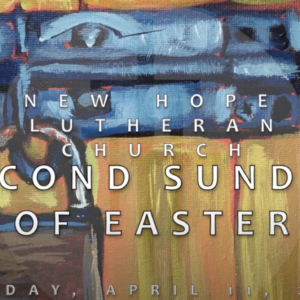John 20:19-31
19 When it was evening on that day, the first day of the week, and the doors of the house where the disciples had met were locked for fear of the Jewish authorities, Jesus came and stood among them and said, “Peace be with you.” 20 After Jesus said this, he showed them his hands and side. Then the disciples rejoiced when they saw the Lord. 21 Jesus said to them again, “Peace be with you. As the Father has sent me, so I send you.” 22 When Jesus had said this, he breathed on them and said to them, “Receive the Holy Spirit. 23 If you forgive the sins of any, they are forgiven; if you retain the sins of any, they are retained.”
24 But Thomas (who was called the Twin), one of the twelve, was not with the others when Jesus came. 25 So the other disciples told him, “We have seen the Lord.” But Thomas said to them, “Unless I see the mark of the nails in his hands, and put my finger in the mark of the nails and my hand in his side, I will not believe.”
26 A week later his disciples were again in the house, and Thomas was with them. Although the doors were shut, Jesus came and stood among them, and said, “Peace be with you.” 27 Then he said to Thomas, “Put your finger here and see my hands. Reach out your hand and put it in my side. Do not doubt but trust.” 28 Thomas said to Jesus, “My Lord and my God!” 29 Jesus said to him, “Have you believed because you have seen me? Blessed are those who have not seen and yet have come to trust.”
30 Now Jesus did many other signs in the presence of the disciples, which are not written in this book. 31 but these are written so that you may trust that Jesus is the Messiah, the Son of God, and that through believing, you may have life in his name.
—————
Please pray with me this morning, church:
Wounded and resurrected God,
Our lives are full of doubt.
We doubt ourselves, we doubt each other,
We doubt you.
Show us yourself again this morning.
Show us that you are wounded, just as we are wounded.
And that through your suffering, comes our healing.
Amen.
—————
I’ve never broken a bone in my body. And I’ve only gotten stitches less than a handful of times.
This is not because I’m a careful or graceful person…truly, I’m a complete klutz and it’s a wonder I haven’t seriously injured myself up to this point…but I do consider myself lucky
One injury in particular, where I’ve received stitches before, is fairly visible. And while I’ve never had any broken bones in my body, I have fractured a bone before, and that wound isn’t visible at all. And I’ve talked about both of these injuries before, I think. When we were younger, we had a trampoline in our backyard, and this was in the age before the nets and walls and whatnot, and my sister and I were doing flips and stuff, as you do on trampolines…and I did a front flip, didn’t quite get all the way around, my heels landed on the trampoline and my body kept going forward, and I smacked my chin into my knee and busted my chin wide open…and you can still see where I had to get stitches. Many years later, in college, we were playing sand volleyball, and because I’m not a graceful person, as I said earlier, a ball was going over my head, so I started backpedaling, and got my legs tangled up under me, jammed my left heel in between my right foot ring toe and pinky toe, and fractured my right pinky toe…a very unglamorous injury.
One wound, you can see very clearly if you’re looking. The other, you wouldn’t know, even if I had my shoes off or was wearing flip-flops.
Sometimes our wounds are quite visible.
Other times…often times…some of our deepest wounds are not.
Jesus shows up…behind locked doors…and pronounces peace and shows the disciples his wounds and scars. The Resurrected Christ bears the marks of his suffering and death.
And I want to say here, big credit for this insight goes to Vicar Laura Anderson. Vicar Laura is the Vicar, or Pastoral Intern, at St. Peter Lutheran Church down in Bay City, and she brought this insight to our weekly text study and I thought it was just so wonderful and really helpful…
Even in resurrection, Jesus still carries the very visible wounds and scars of everything that had just happened to him. And not only that, but he shows these wounds to the disciples and later he’ll ask Thomas to touch his wounds. Jesus doesn’t deny these wounds. He doesn’t hide them away or cover them up. They are a witness, a testament, to what has happened to him. Jesus’ wounds are part of his story, just as much as the resurrection is.
That’s not always us, is it? We’re wound- and scar-averse people. We don’t always carry our wounds proudly or let people in to see all of our scars. Our wounds and our scars can carry a good deal of shame for us.
But Jesus doesn’t do that. Jesus is very forward with his wounds.
Crucifixion was an extremely shameful thing. It was one of the most humiliating ways someone could die. I mean, imagine, stripped of your clothing, mocked, spit on, hoisted up on beams on a hill outside the city, actually where the city dumped it’s trash, up on a hill right along a road, where anyone who was coming in or out of the city would see you…whether it was burglary, or violence, or treason, or inciting sedition…all those people would see you and see your crimes. They’d see all your wounds, all your scars, only the worst parts of you…as if your whole life was reduced to that crime and shameful punishment…
Shameful.
But then Jesus comes and stands in the midst of his friends, frightened and alone and hiding away in their own shame—Jesus comes and stands in their midst and speaks a word of peace. And shares his painful wounds and scars. And by inviting them to behold and witness and touch his scars, Jesus reclaims them. Jesus takes the shameful wounds and takes away their power to be shameful. Jesus robs them over their power. Jesus takes shameful wounds and scars and hurt and pain, and turns them into the means of salvation. Jesus’ wounds become the source of our healing and wholeness.
So that you would not be made feel shame for your wounds and scars.
Sometimes our wounds are quite visible.
Other times some of our deepest wounds are not.
But we are fundamentally different people after our wounds. Wounds change us. The resurrected Christ didn’t come stand amidst the disciples as the person they had known before that awful week in Jerusalem. The resurrected Christ came bearing the wounds and scars of a scornful and shameful death. Christ’s wounds and scars were visible and tangible.
Even if our scars aren’t so visible, the effects of those wounds linger with us.
But we are meant to share our wounds together. We are made for bearing witness to, caring for, and touching one another’s deep hurt. It’s often through our wounds that we experience the love of God most deeply.
This is the vision for the church that the author of Acts paints for us this morning. A vision of a community that not only cares about one another’s needs, but a community that provides for each other’s needs. The earliest Christian church was a community of faith where everyone felt responsible for the well-being of their neighbor. Every single person felt invested in everyone else’s needs and would provide for their needs out of what they had. Not just spiritually, but materially as well.
Our life, church, is intended to be shared. We are meant to provide for the needs of our neighbors, we are meant to be invested, not just in caring about each other’s needs, but in providing for them.
This is what it means to be in community. It is spiritually and physically upholding one another.
Over the past more than a year, there have been some serious wounds that have occurred. Keeping apart and distanced from people we care about, in the interest of health and safety…those distances hurt, and they cause wounds. Keeping away from our church building, in the best interest of health and safety…that kind of exile hurts, and it can cause wounds. Missing out on birthdays and milestones and first steps and proms and graduations, in the best interest of keeping people safe and healthy…missing out on those moments hurts, and causes wounds. The division and hurt caused by rhetoric and our inability and unwillingness to have difficult conversations…that kind of fracturing among family and friends hurts, and wounds deeply.
So as we begin to take steps forward out of this pandemic, why do we think that we wouldn’t carry these wounds and scars with us? We are not what we once were. We are a different community of faith than we were a year ago…we are different people than we were a year ago…we will bear scars from this, church.
But why should those scars be a source of pain? Why should we feel shame about those wounds?
The promise of the resurrection is that God is making all things new, not that God is making all things back like they were before. God is doing a new thing here, too. We won’t be what we were before, we’ll be something new, something different, something transformed…something resurrected.
Just like I think we felt the deep hurt of Good Friday in a profound way this year, I think, too, we’ll experience even more fully what it means to live as resurrected people as we begin to emerge from this time of long shadows.
How will we honor the scars and wounds we’ve received this past year? How will we grieve what’s been lost, but look and move forward in hope? How will we not feel shame about what we’ve experienced, but rather look to these scars as places for healing?
Put your fingers here in Christ’s hands. Touch Christ’s wounded side. Do not doubt, but trust.
Trust that resurrection is still on its way.
Trust that even these scars can be redeemed.
Trust that we won’t be what we were before, but we will be part of the new thing God is bringing forth.
Trust that Christ’s wounds and scars are true sources of your healing and wellness.
Trust that Christ’s peace…is yours.

